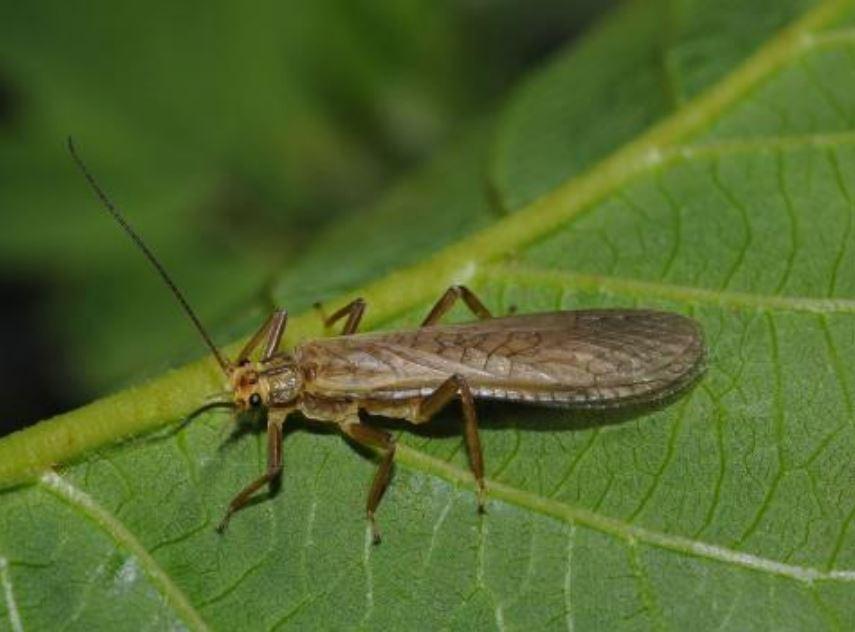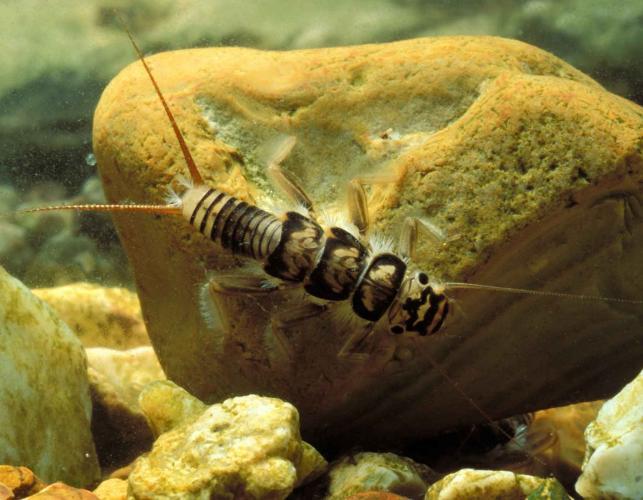Moderate-
High
The population size of Rainier roachfly is low in Washington and the population trend is unknown. They are in the Plecoptera order of insects, commonly known as stoneflies. Stoneflies generally require cold, clear, running water and are especially sensitive to human disturbance; they are excellent indicators of water quality. An estimated 43 percent of North American stoneflies are vulnerable to extinction, imperiled, or extinct.
Description and Range
Physical description
Adult stoneflies have two sets of clear, fine-veined wings that lay close to the body. These insects have long, thin antennae. The larvae (nymphs) look like wingless adults, but often have external gills, which may be present on almost any part of the body. Depending on the species, stonefly nymphs range in size from ½ to 1 ½ inches in length not counting appendages.
Ecology and life history
The Rainier roachfly occurs in spring-fed seeps and streams (rheocrenes). Nymphs in this genus are generally collected in seeps and in the splash zones of small springs and streams.
Stoneflies usually live in areas with running water, and are important predators and shredders in aquatic ecosystems. Adults are terrestrial and can be found near aquatic habitats with running water, resting on rocks, debris, and vegetation. As nymphs, stoneflies live in aquatic habitats, mainly along the bottom of cool, clean, flowing waters with relatively high oxygen concentrations, mainly on rocky, stony, or gravel substrates.
The females lay hundreds or even thousands of eggs in a ball which they initially carry on their abdomens, and later deposit into the water. The eggs typically hatch in two to three weeks, but some species undergo diapause as eggs during the dry season. The nymphs physically resemble wingless adults, but often have external gills, which may be present on almost any part of the body. The nymphs (technically, "naiads") are aquatic and live in the benthic zone of well-oxygenated creeks and lakes.
In early stages (called instars), stoneflies tend to be herbivores or detritivores, feeding on plant material such as algae, leaves, and other fresh or decaying vegetation; in later instars, the nymphs of many species shift to being omnivores or carnivores, and some species become predators on other aquatic invertebrates.
The insects remain in the nymphal form for one to four years, depending on species, and undergo from 12 to 33 molts before emerging and becoming terrestrial as adults.
Stonefly adults are generally weak fliers and stay close to stream, river, or lake margins where the nymphs are likely to be found. The adults emerge only during specific times of the year and only survive one to four weeks.
As adults, very few stonefly species feed but those that do, feed on algae and lichens, nectar, or pollen.
Geographic range
The Rainier roachfly is known from around fifteen occurrences within Mt. Rainier National Park, Pierce County, Washington. The species is presently known only from the Mt. Rainier National Park, but may occur elsewhere.
Climate vulnerability
Sensitivity to climate change
Moderate-
High
The Rainier roachfly has only been documented within Mt. Rainier National Park (mostly on the west side). It is found in seeps, springs, and small spring-fed streams. Climate sensitivity for this species is tied to melting glaciers and an associated rise in stream temperatures. Relatively little is known about this species, but stoneflies as a whole are sensitive to drought or precipitation changes that may affect seep moisture, springs, and stream flow. Decreased water quality, habitat fragmentation and nearby development also alter the quality and availability of suitable habitat.
Exposure to climate change
Moderate-
High
- Increased water temperatures
- Reduced glacier size and increased glacier melting
- Changes in precipitation and/or drought
- Altered flow regimes
Conservation
Conservation Threats and Actions Needed
- Resource information collection needs
- Threat: Lack of data on current status and distribution.
- Action Needed: Determine distribution and population status.
- Climate change and severe weather
- Threat: Potential for springs to dry up.
- Action Needed: Monitor spring/seep habitats.
See the Climate vulnerability section for more information about the threats posed by climate change to this species.
Decreased water quality, habitat fragmentation and nearby development also alter the quality and availability of suitable habitat.
Resources
References
Jordan, S. F. 2013. Soliperla fender (Jewett 1955). Species Fact Sheet. The Xerces Society. Prepared for the Interagency Special Status/Sensitive Species Program, Forest Service, Bureau of Land Management. 5 pp
Kondratieff, B. C. and R. A. Lechleitner. 2002. Stoneflies (Plecoptera) of Mt. Rainer National Park, Washington. Western North American Naturalist 62(4): 385–404.
NatureServe. 2014. NatureServe Explorer: An online encyclopedia of life [web application]. Version 7.1. NatureServe, Arlington, Virginia. Available http://explorer.natureserve.org. (Accessed: September 22, 2014 ).
Stark, B. P. and D. L. Gustafson. 2004. New species and records of Soliperla Ricker, 1952 from western North America (Insecta, Plecoptera, Peltoperlidae). Spixiana 27(2):97-105.
US Fish and Wildlife Service (USFWS). 2011. Endangered and threatened wildlife and plants; 12-month finding on a petition to list the Bearmouth mountainsnail, Byrne Resort mountainsnail, and meltwater lednian stonefly as endangered or threatened. Federal Register 76(65): 18684-18701.
Other resources

